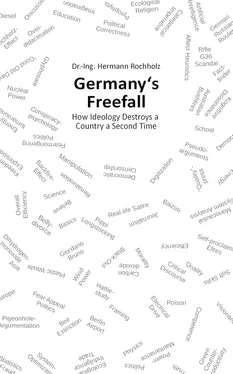Since the laws of nature can’t be violated, as is possible with legal laws, they act as the “spoilsports” of visionaries, of whom two variations exist:
The first tries to violate the laws of nature directly, for example, by ignoring the law of conversation of energy.
The second ignores physically predefined efficiencies, which are usually significantly smaller than 100%. I take up this subject in detail on the following page.
First, I use general examples to illustrate the complexity of technical problems. Some of these have little to do with the contents of this book. If I were to discuss the efficiency of hydrogen cars right off the bat, the brains of a hydrogen proponent would then kick into “strike” mode. The “backfire effect” sends its regards (see Backfire Effect).
Efficiency is the ratio of what comes out at the back to what is put in at the front. Efficiency in all technical processes is less than 100%. 7When, for example, an electric motor converts 80% electrical energy into rotational energy (see chapter Energy and Supply), it is then 80% efficient. The remaining 20% of this electrical energy represents the incurred “losses”. According to the law of conservation of energy, these are not really lost, but converted into another form of energy: heat loss. If this isn’t properly dissipated, the engine will break down.
When you connect several technical processes in series, you can easily calculate their overall efficiency by multiplying the efficiencies (not the losses!) of the individual processes. If, for example, the efficiency of a coal-fired power plant is 40%, i.e. 0.4 (correct on average), the efficiency of the electric motor intended to drive something is then 80%, and the efficiency of the electric grid is then 92% (8% losses). You calculate this as follows: 0.4 × 0.8 × 0.92 = 0.294. In concrete terms, this means that 29.4% of the combustion energy of coal is converted into the rotational energy of this electric motor.
Efficiency is close to 100% only in a few technical processes. These are pure combustion processes, electrical processes and processes with incompressible fluids (water).
In all other technical processes (mostly so-called “circular processes”), which have to do with gases or where combustion is associated with a mechanical drive (gas turbine, internal combustion engine), efficiency is significantly below 100%.
This is a physical and not a technical limit.
Improvement is not possible.
The Last Percentages – Cutting Losses
“Nach fest kommt ab!” (Tight is followed by off!) says the German fitter when tightening a bolt. This means nothing else than that anything overdone makes no sense and is even counterproductive.
This can easily be illustrated: When we assume that a large electric motor has a connected load of 100 kW (it needs 100 kW from the electric grid), but the mechanical load is only 50 kW, it will then have 50 kW in losses (which are usually lost as heat). If you want to improve this motor and make it produce 1 kW more mechanical power, then you have to reduce the losses by 1 kW. 1 kW better at 50 kW corresponds to a 2% improvement. In doing so, the losses must be reduced by 2%. This seems simple.
Technical devices are better nowadays, however. Efficiencies are much closer to the maximum achievable value. Assuming that a modern motor with a 100 kW connection load converts 80 kW into a mechanical load, this means 20 kW are lost. If you want to improve this motor by 1 kW, this means a 1.25% improvement. The difficulty here: Any losses have to be reduced by 1 kW from 20 kW to 19 kW. That’s 5%. That’s a lot.
It’s therefore much more difficult to achieve any improvement when trying to optimize systems that are highly optimized already. Most of the time this kind of thing is associated with a lot of effort. It’s easy to reach an explosion in costs. That’s why you have to find a financially acceptable compromise most of the time.
You are constantly being confronted with new rules and guidelines. Technicians and engineers have “standards” for this. This is currently getting out of hand. Standards and guidelines aren’t the same in every country since the conditions aren’t the same. The purpose of standards is safety. Road traffic regulations are also written for safety’s sake.
In order to draft standards and guidelines, experts convene in order to discuss these. The difficulty is that as these experts try to prevent accidents, rules must be formulated in such a way that they don’t lead to an incapacity to act. This is even stated in the standards. Expert knowledge is therefore necessary to draft them. By the way, standards must always be adapted to the “state of the art”.
Not every innovative technology is beneficial everywhere. For example, aeronautical engineering is “conservative”, and innovations find their way into the market only very slowly. The failure of a single component can mean hundreds of deaths. That’s why computer-only control of an aircraft is prohibited (every processor is faulty) and why it’s mandatory to install important sensors twice (called redundancy). Electric airplanes designed for passenger transport are difficult to make because each battery must be monitored individually, since an airplane will crash in case a battery catches fire. Boeing can tell you a thing or two about this after they installed new types of batteries solely to power their instruments, and these had started to burn. The planes were “grounded”, just like the Boeing 737Max today. Even a Tesla car had posed insurmountable problems in Austria for several weeks because it wasn’t possible to transport the burnt-out vehicle wreckage. Electric cars had been approved, but nobody had considered the fact that this kind of a car could catch fire as well. Incidentally, 50 years ago, the German “NSU Prinz” automobile was dubbed “a lighter on wheels”. The registration authorities do know that cars can burn.
It took Airbus a long time to obtain the approval for components that weren’t made of aluminum but of fiber-reinforced plastics. Such a thing wasn’t permitted at the time, but was already standard in glider construction. Many tests proved that the components would be able to withstand the imposed loads. Then certification was assured and everything seemed fine. One was astonished to find that these airplanes were becoming heavier and heavier. The reason was that plastics soak up a certain amount of water (~1%), demonstrating that even the experts sometimes fail to consider the little things like this. In this case, it was of no critical importance, but in an airplane with a structural weight of 30 t, 1% also means missing a payload of 300 kg.
All in all, these rules and laws exist to make life as free as possible from any danger. However, these must be written in such a way that the limits are not too stringent in order for any action to be possible at all.
Furthermore, laws mustn’t conflict. For example, measles vaccination has become mandatory in schools. However, if a student refuses to get vaccinated then this means a conflict with Germany’s law of compulsory education.
The following lists examples showing that expertise in the respective area is required in order to be able to report on or evaluate these. Other examples show that supposed trivialities can bring down entire concepts.
Both can only be met with knowledge and competence.
This section applies the chapter entitled “ The Last Percentages – Cutting Losses” to wind turbines.
The most efficient wind turbines achieve an overall efficiency of 50% (including all electrical and mechanical losses) at certain operating points. About 59% is the maximum that’s possible, as the scientist Betz had already calculated in 1919. This is the physical limit; more is not possible. Compared to the maximum achievable, these systems thus have an efficiency of 0.50/0.59, which corresponds to 83%. That’s darn good.
Читать дальше











